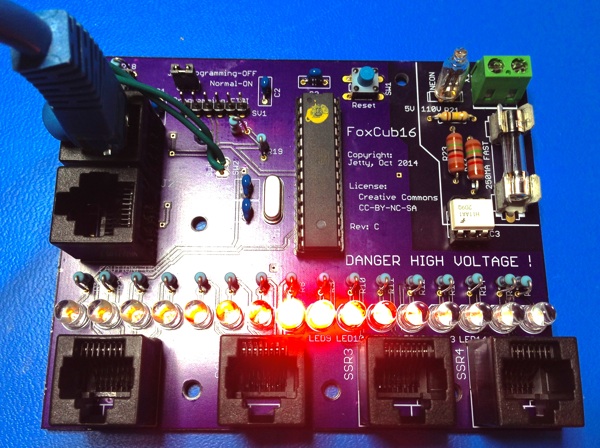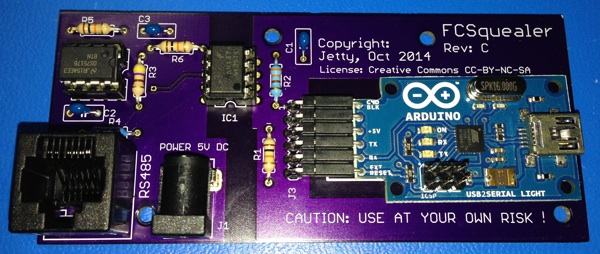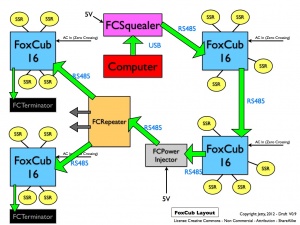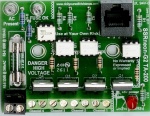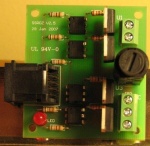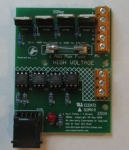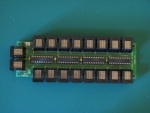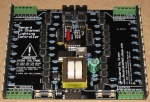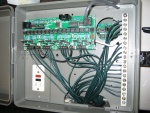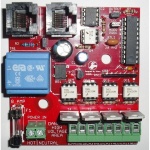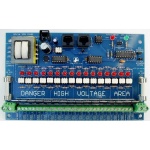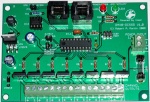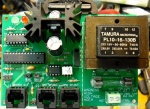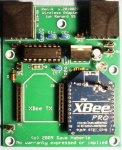Electronics Hardware
This page contains links to ChristmasWiki entries relating to electronics hardware. It also has an overview of various types of DIY hardware that works with Vixen software.
Links
Hardware Design Guidelines- The DIYC community standard for hardware design. It is recommended that you check your electronic device and PCB designs against this standard.
Co-Op Boards and Assembly Instructions- Assembly instructions and documentation on boards that can be obtained through a DIYC COOP.
Comparison of DIY Boards- Charts that compare statistics on various COOP boards, including their channel count, cost, and COOP status.
Renard Main Page- Renard is a simple PIC-Based Light Dimmer Controller for use with Vixen.
Solid State Relays- Solid State Relays (SSRs) are used for switching of mains-voltage lights in a computerized display.
DMX to Grinch/595 convertor- How to make your Grinch speak DMX.
Olsen 595- How to make an Olsen 595 controller at home.
DMX ROBO Spot Light- How to build a Robotic Full Color Spotlight.
Control boards and Contacts- list of board designs found on DIYC and contact sources for them.
Compatible Serial Adapters- list of known serial port adapters that will work with our displays.
Overview of DIY Hardware Approaches That Work With Vixen
This section provides information about Do-It-Yourself (DIY) hardware that works with the Vixen software program. Vixen is a Windows (.NET Framework 2) program that runs on a PC, and is used to create and run light shows that may be synchronized to music. Here is a brief list of the DIY approaches that you can take that will work with Vixen.
Non-Dimmable Light Controllers
SSR Direct Attach
- Controlled through: Parallel Port
- Documentation: Solid State Relays
If you need 12 or fewer channels, you can just buy or build SSRs and connect them to the parallel port on your PC, and use them to turn 110VAC light strings (or just plain lamps) on and off (no dimming). These ssrs must be sourced or positive switched. From time to time there are coop buys of SSR boards,but these are usually sinked, and/or parts, to reduce your expense. You could place a couple ULN2803s and use the coop sinked ssrs. For more information on this come over to the forum and/or ask on the LiveChat.
Kit74
- Controlled through: Parallel Port
This is a kit with mechanical relays that can be purchased from various places. It is similar to the SSR Direct Attach, although the mechanical relays are noisy and have a limited lifespan. There are probably other similar kits available as well.
Hill320
- Controlled through: Parallel Port
- Documentation: http://computerchristmas.com/christmas/link-how_to/HowToId-4/How_To_Build_A_Parallel_Port_Controller_Box
This is a controller originally designed by Hill Robertson http://computerchristmas.com to allow up to 320 channels to be controlled by a PC, and requires an external power supply and SSRs. There isn't any coop board for this design at the moment. It is a more complicated design, and it is not currently recommended for newbies.
Olsen 595/Grinch
- Controlled through: Parallel Port
- Documentation: The GRINCH Controller, GRINCH Controller Assembly Instructions
- Documentation: Olsen 595
This is a popular controller based on an approach first popularized on the http://computerchristmas.com and/or http://planetchristmas.com forums by Peter Olsen. In its first incarnation it used 8-bit 74HC595 logic chips, often with external buffers, while a later design (Grinch), popularized by Robert Jordan, uses 16-bit chips specialized for this use. There are coop boards available for both of these designs. These coop boards need external power supplies, and work with external (coop) SSR boards to control AC lighting.
There are some variations of this approach that support dimming, but they are not as popular and there aren't any coop boards available. However, using a Ren-C board can add dimming capability to a 595 or Grinch, which causes the board to operate as a Renard board. There is also an option available to run a Grinch or 595 controller from DMX with full dimming capability HERE.
The Grinch board is a good choice if you need more than 12 channels but want a board that is simple to build. It doesn't use very many parts, and is easy to assemble.
Fox Cub Overview
Please see the standard Disclaimers
Overview
Fox Cub is an Arduino Based RS485 Renard compatible dimming controller system that's designed to be very cost effective and simple to build / configure. The system has been designed to keep external cabling costs low. It also provides the ability to test channels and configure addressing in the field without the need for a computer during setup. Additionally it has a full 256 levels of dimming and on board zero cross detection. It can be used for centralized, decentralized or mixed layouts depending on boards used.
Arduino
FoxCub16 (the controller board) is based around a minimalist Arduino, which is an Arduino with unnecessary parts removed. The design uses the ATMega328p, which is the most cost effective choice for the number of channels and distribution of lights around a layout. Software is uploaded via the Arduino IDE. The ATMega328 is the same chip used in the Arduino Uno / Duemilanove.
Features
- Compatible with Renard
- 110VAC design. (240VAC will need adjustment for Zero Cross Detection).
- Renard RS485 compatible, uses standard RJ45 connectors.
- Very cost effective
- High channel count. Standard software handles 256 channels. Up to 1150 channels with minor software change and 115200 baud.
- 60/50Hz - 256 levels of dimming with zero cross detection on board
- In field addressing / baud rate configuration
- In Field Testing (no computer required):
- All Channel On
- All Channels Dimming
- Channels Stepping in Sequence
- Larsen Scanner
- Zero Cross Detector Operation Verification
- One firmware, no need to switch firmwares for testing and operation.
- Opto isolated from computer for protection
- Optional repeater for decentralized layouts
- Onboard test leds, 1 per channel, 16 in total
- Easy build. Single layer, PCB's can be built at home. Could also be built on stripboard.
- External 5V power to keep costs down
- Runs at 4800, 9600, 19200, 38400 or 115200 baud.
- Onsite programmable for software updates
- Small, 8cm x 10cm
- Inactivity Timer, lights switch off after 1 min if active communication ceases.
- Works in colder temperatures too. All critical components are spec'd down to -40C, making it suitable for adverse climates in Alaska / Canada.
The Pieces and Layout
- FCSquealer: Converts serial from computer to RS485 (opto isolated)
- One required per display
- FoxCub16: 16 channel controller
- One required per 16 channels
- FCRepeater: 4 channel RS485 repeater
- Optional, used only in decentralized or very large displays
- FCPowerInjector: Supplies 5V power to the system
- One required per display
- FCTerminator: Terminates an RS485 run
- One required for centralized displays, or per every branch on decentralized or large displays
The following diagram illustrates the various layout options (click image for larger version):
Part Cost
(as of Dec 2012, supplier Mouser):
- FCSquealer: $20.99
- FoxCub16: $18.93 + $2.94(Zero Cross Detection) = $21.87
- FCRepeater(4 Channel): $15.45
- FCPowerInjector: $2.95
- FCTerminator: $0.76
SSR Selection
Will drive AC or DC 4-Port SSR's at 50/60Hz. If you are driving DC SSR's, you can omit the AC components from FoxCub16. SSRNeon is recommend if you are home etching: SSRneon
Maximum Channels
FoxCub16 is a 16 channel controller which can be cascaded for more channels. The maximum
number of channels is the same as Renard and is governed by your refresh interval and baud rate as per this chart:
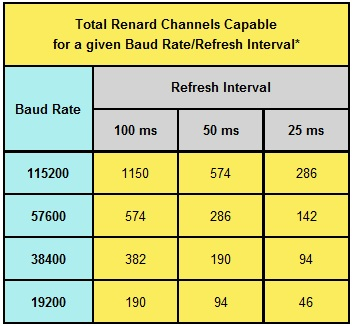
YouTube Video
Operational and Testing Videos:
Credits
This design pays homage to the wonderful work by the designers / contributors to Renard / SSRneon and this site.
Additional Disclaimers
This design uses high voltages. You are responsible for your own safety, make sure you know what you're doing or use a qualified electrician. USE AT YOUR OWN RISK.
Pixel Controllers
- Controlled through: DMX, Renard or most commonly E1.31
- Documentation: Controllers
Pixels are a form of RGB lighting that allows individual (or a group) of LED to be individually controlled through a rainbow of colors. For more information, look at Things You Will Need To Get Started With Pixels
Other Controllers (Signs, Servos, etc.)
LedTriks
- Controlled through: Parallel Port
- Documentation: LedTriks Controller Assembly Instructions LedTriks Wiring Diagram
This board controls low-voltage LED panel and was designed by Robert Jordan. These panels are typically 16 LEDs high by 48 LEDs wide, for a total of 768 LEDs. Vixen can control up to four panels through one parallel port, and can even display text.
One of the problems with the original LedTriks design was the load placed on the PC to chunk the data out the parallel port. The Triks-C and the PIX-C controllers were created to address these shortcomings.
Triks-C
- Controlled through: Serial port or USB/serial adapter.
- Documentation: TRIKSC, Manual in PDF format
This is a an add-on controller/processor for the LedTriks. The TRIKS-C uses an ATMEL processor to take a LedTriks file and send it out to the LedTriks Controller, via the serial port.
LEDTRIKS LED PANELS
- Connected to LEDTRIKS Controller: via CAT5 cables.
- Documentation: LEDTRIKS Panel
This is a an add-on controller/processor for the LedTriks. The TRIKS-C uses an ATMEL processor to take a LedTriks file and send it out to the LedTriks Controller, via the serial port.
PIX-C
- Controlled through: Serial port or USB/serial adapter.
- Documentation: PIX-C
This is an add-on controller/processor for the LedTriks. It is backward compatible with the TRIKS-C, and is based on the Microchip 16F688 processor.
JEC Pixel Displays
- Controlled through: DMX
Pixels are a stand-alone lighting fixture controlled by DMX-512. Each pixel has banks of red, green and blue wide-angle LEDs, currently six of each. Firmware is available in two versions: 3 and 4 channel. 3 channel requires a dmx channel for red, green and blue intensity. Four channel adds master intensity control to the original three.
Pixels require a stiff +12v switching power supply. Each circuit board draws ~ 130 mA at full brightness. Pixels chain together using standard CAT5 networking cable. Per the DMX spec, no more than 32 pixels should be connected together without using an optosplitter / signal buffer.
LED refresh rate is nearly 100 Hz.
More details can be found at http://www.response-box.com/rgblights
Currently in progress is a version of the firmware which will allow the DMX address to be changed in the field. Currently the address is hard-coded.
rgbLED
- Controlled through: Serial Port
The RGB LED's will have the ability to make hundreds of colors with a single led. They can be controlled individually, series, or parallel with each other. These are not able to be addressable individually as they have no control onboard. You will have to use DCSSR's, Franks Ren24LV, or a Grinch to turn each channel on and off to get the desired color. Each RGB LED will use 3 channels, 1 for each color. These would give you the ability to make strings out of these to have any color you want. It will also use less power compared to standard mini lights.
More information to follow as I start my testing.
Color Stick
- Controlled through: DMX
- Documentation: Color Stick
The color stick is an 8-channel RGB display that uses 16 RGB 5050-sized LEDs, two per channel. The color sticks can be connected end-to-end as they pass DMX.
Kostyun RGB+W Super Strip Flood
- Documentation: Super Strip
RS485 Splitter
- Documentation: RS485 Splitter
The RS485 splitter is a 4-port non-isolated splitter, designed for driving the color stick, but useful for driving any RS485 devices, including DMX or Renard.
F.A.S.T. Finally Affordable Snowfall Tube
- Documentation: FAST Finally Affordable Snowfall Tube
TIR Destiny CG Commercial LED Flood Light
- Documentation TIR Destiny CG Commercial LED Flood Light
Solid State Relays (SSRs)
- Documentation: Solid_State_Relays
Solid State Relays are stand alone devices that work between a lighting controller and strands of lights or other devices. There are both AC and DC versions.
.
FM Transmitters & Antennas
- Documentation: General info on FM transmitters and links to pages describing specific models of transmitters
Almost everyone that builds a system to synchronize their lights to music broadcasts that music on a local FM frequency. This section covers the DIY aspects of FM Transmitters and Antennas.
.
DMX Boards, both converters and light controllers
This section is under construction, please consider all links broken below
- Documentation: Information on DMX Dongles and DMX Bridges. i.e. The devices that interface your PC to a DMX network
Almost everyone that builds a system to synchronize their lights to music broadcasts that music on a local FM frequency. This section covers the DIY aspects of FM Transmitters and Antennas.
.
Pictures of Various Coop Boards (mostly assembled)
- Coop Boards (mostly assembled)
-
Renard SS 8
-
Renard SS 16
-
Renard SS 24
-
RPM USB to DMX Adapter
-
RPM DMX4 SSR
-
RPM DMX16 SSR
-
RPM DMX8 DC SSR
-
RPM DMX16 DC SSR
Commercial Products Supported By Vixen
Digital Input/Output Cards
- PCI-DIO-96 by National Instruments
- Elexol USB I/O 24 - (Plugin by Jonathon Reinhart)
- Elexol Ether I/O 24 - (Plugin by Jonathon Reinhart)
